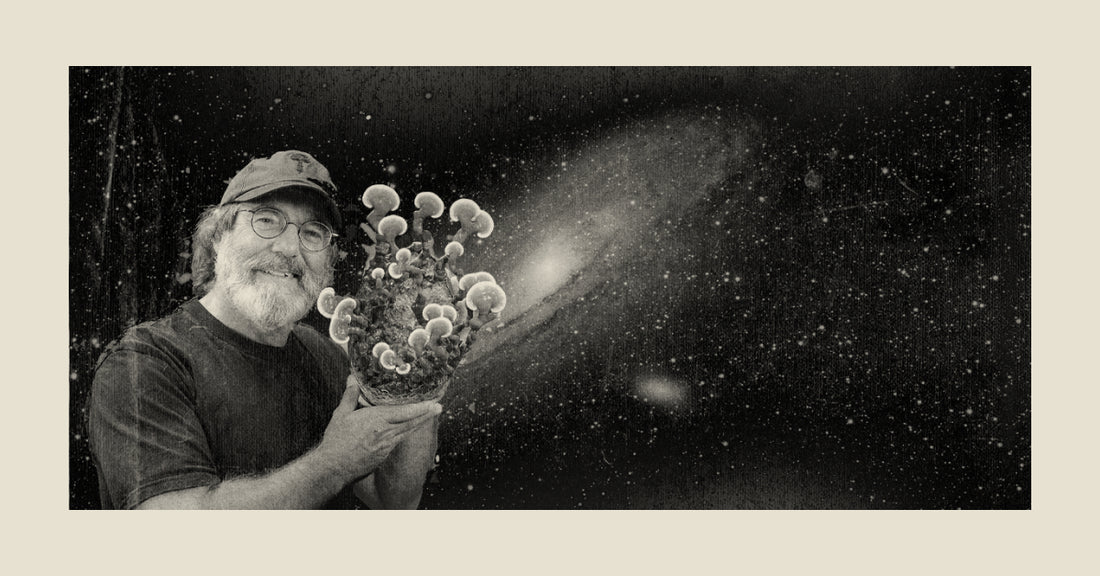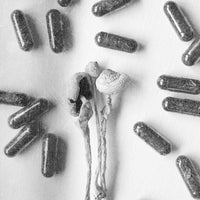Before you read any further, head to your search bar and type in literally anything about mushrooms, then click on the first result. Now do a Ctrl+F for “Paul Stamets.” Lo and behold, the mycelial maestro will almost certainly have a mention. It’s hard to have a conversation about mushrooms these days—medicinal, psychedelic or otherwise—without a passing reference to the man in the mushroom hat.
But there’s more to Stamets than meets the eye. Under that hat is a brain that has little time to pause; it seems like every week, we’re hearing about a new project, venture, or crazy idea he’s posited on some podcast or other.
With that in mind, allow us to flex our Stamets knowledge so you’re armed with some useful trivia on your next foraging expedition.
He’s working with NASA to put mushrooms in space
Yes, really. While we don’t have all the details, Stamets announced earlier this year that he’s teamed up with a cohort of NASA scientists to investigate the uses of mushrooms in space.
The project has two stages: the first involves determining which fungi would be best suited to help with the breakdown of regolith from asteroids (i.e. can mushrooms help us create an outer space greenhouse?) The second stage is a little bit wild: Stamets and the team are investigating how mushrooms can help us grow or build structures on other celestial bodies. This emerging field has the rather zingy name of mycotecture.
NASA is staying firmly tight-lipped on the project, but in a separate interview, Stamets has hinted that “magic” mushrooms could help astronauts deal with anxiety and depression on their return to earth.
Watch this, um, space?
Stamets’ famous hat is made from … yep, you guessed it
It’s a mushroom hat. Specifically, it’s made from amadou, a spongy material that grows from Fomes fomentarius and similar fungi. When you hear about “mushroom leather” and “mushroom materials” being used in new-fangled clothes or products, they have more than likely come from a similar source. Look, we’re learning!
He’s a bona fide film star at this point
Stamets’ reputation precedes him, and because of this, he’s often been used as a talking head in films, TV and documentaries that shine a light on the mycelial world. You only need to look as far as the recent Netflix series How to Change Your Mind, DOSED, or the Burning Man 2.0 film for evidence.
But, with 2020’s Fantastic Fungi, Stamets stepped into a more central role. While he features throughout, it’s when the documentary gets to exploring psychedelic mushrooms that Stamets takes center stage, and becomes an essential part of the storytelling.
He’s an entirely self-taught mycologist
Born in Salem, Ohio in 1955, Paul Stamets credits his late brother John for spurring his interest in all things mycelial. “John was a force of nature,” Paul said in his brother’s 2014 obituary. “He inspired me on my path into the field of mycology, after his travels to Mexico and Colombia in pursuit of magic mushrooms.”
Nowadays, Stamets is without a doubt the world authority on mushrooms. He did study Mycology as an undergrad, but has no further educational credentials, despite his worldwide reputation. He is what we call an autodidact—someone almost entirely self-taught in their chosen field.
“Magic” mushrooms cured his stutter
OK, maybe you do know this story. Stamets has told some versions of it throughout the years, often toned down or sanitized for the sake of the audience, but it’s his appearance on episode #1035 of the Joe Rogan Experience where the truth comes out.
As a child, Stamets suffered from a debilitating stutter. Then, one day, he didn’t. Speaking with BioHabitats, Stamets describes the experience: High on mushrooms, he climbed a tree in the middle of a rainstorm. Frozen by fear (and psilocybin intoxication), he decided that something good must come from the situation.
“I thought about what the biggest problem was in my life, and by far, it was my inability to communicate because of my stuttering. So I started repeating the mantra ‘Stop stuttering now. Stop stuttering now.’ in between lightning strikes. I must have said it hundreds of times. Fortunately, I did not get struck by lightning.
“Later, I climbed out of the tree, walked home, and went to bed. The next morning, I encountered a young lady I had been attracted to. She was kind, but most women are more attracted to self-assured, confident young men. I saw her coming, and instead of staring at the ground as she approached me, I looked straightforward. My eyes met hers and she said, ‘Good morning, Paul.’ I said ‘Good morning’ back, without stuttering. I had stopped stuttering in one day.”
He’s helping to save the bees
One of the greatest threats to our survival in 2022 is the widespread loss of pollinating insects across the globe. However, the main culprit of colony collapse disorder, which bee populations across the globe are more frequently experiencing, isn’t human nature, but a virus. Stamets has even found a way for mushrooms to save the bees from disaster.
Speaking to Biohabitats, he summarizes the research:
“By far, my greatest recent discovery is that I think I have found a way to save bees from colony collapse disorder. Just yesterday, we got more research results on polypore mushroom reducing viruses in bees. Through our research and tests with the USDA and Washington State University, we have found that extracts of the mycelium of agarikon, reishi (Ganoderma lucidum), chaga (Inonotus obliquus), amadou (Fomes fomentarius)—all polypore mushrooms that grow in the woods—dramatically reduce the viruses considered to be the primary cause of colony collapse disorder.”
He’s already been to space (well, sort of)
If you’ve caught an episode of the new Star Trek: Discovery series, you might have had to do a double-take when you heard Anthony Rapp’s character being addressed. Yep, Rapp plays an astromycologist, who utilizes mushroom mycelium and the study of mushrooms as a Starfleet Science Officer. His character’s name? Lieutenant Paul Stamets. Obviously.
“I’ve been a Star Trek fan all my life,” Stamets told Trends w/ Benefits earlier this year. “I told them that they actually have a sort of a sacred mission: [To make] science fiction become science fact.”
He’s helping to revolutionize crowdsourced scientific studies
Quantified Citizen is an app that you can download (yeah, you), and help contribute to scientific research studies through completing various questionnaires. Designed to crowdsource large data sets from the general public and now in its second evolution, Quantified Citizen has so far undertaken the world’s largest microdose study, a global survey of beliefs towards psychedelics, as well as a study of psychedelic use amongst first responders. Stamets has been involved with QC from the start, and today sits on their Advisory Board as their Mycelial Networker.
So there you have it. Next time someone asks you “Who is that mushroom guy?” you’re now armed with a fruiting body of trivia nuggets to say, “That’s Paul Stamets! He is the mushroom guy, but also …”
Andy Ritchie is a writer and editor based in Barbados.
Read more: WTF is Astromycology?
Read more: How Do Mushrooms Communicate?
Read more: 7 Films That Helped Change the Conversation on Psychedelics



